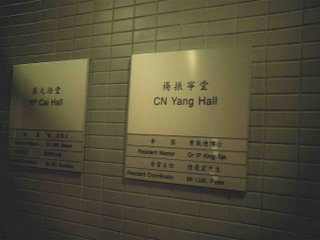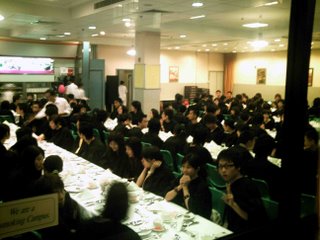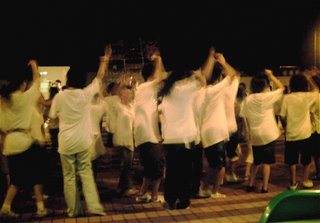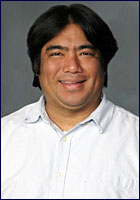Happy birthday
We celebrated Nicole's 20th birthday a few days ago. I left at about 11 pm, but some of the others, including Nicole, stayed out until 6 am. They finally got to bed at 8 am. And found that suddenly, the corridors were full of noise. Noise of orientation for local students.If you've ever been to an orientation for new students at a college, then you know that the college pays people to rile up the new students to make as much noise as they are physically capable of making. Apparently, the folks at HKBU are pretty good at their jobs.
Here's one event I took a picture of after 10 pm tonight:

The main student dorm is divided into the north tower and the south tower. Here's the entrance to the south tower:

Note the turnstiles and the guard. I can't just go in without a specific invitation from a student and some paperwork. Students can get in (and out) using their student card, which has an RFID tag that they just hold up to a box, even if it's still in their wallet.
Each tower is about 20 stories high, and is divided into two halls each. These halls used to be divided by bottom half, top half, but because the bottom half halls were bummed about being less desirable (having no view), they started splitting it by odd numbered floors vs. even numbered floors. The sign to the right of the doors says what halls are in that tower.

As you can see, one of them is named after C. N. Yang. Now Yang is a physicist, and Nobel laureate. I don't know what his connection is with HKBU. But the fact that they named a hall after a physicist is interesting.
Chen Ning Yang, together with Robert Mills, proposed in the 1950s a new way of thinking about the forces of nature. The history of physics might be viewed as a string of such advances in our thinking about the forces of nature. Newton found that gravity and the motion of the planets (and the moons around those planets) could be explained by a single force (the "gravitational force") that is a mysterious attraction that any two objects have toward each other, proportional to their masses and falling off with distance using the "inverse square law". This mysterious "action at a distance" bothered many people over the years, and it's possible to instead imagine that there is a "gravitational field" filling all of space, that interacts with objects. Objects increase the gravitational field, and they also get pushed around by it.
It turns out that a very similar description also works with electricity and magnetism, and the work of Faraday, Ampere, Maxwell, and others in the 19th century showed that electricity and magnetism were fundamentally linked into a single electromagnetic force, with an electromagnetic field filling all of space. This field was found to have a real existence when it was realized that you could generate waves in this field. These waves are exactly what we call "light".
In the very beginning of the 20th century Einstein discovers relativity, and one of the developments in this theory is that gravitation is not a mysterious action at a distance, nor is it a field filling all of space, but rather, it is the result of curved space-time. Trajectories get bent not because of a force, but because they're travelling straight in a curved space-time. One way of thinking of curvature is to imagine the surface of the earth. Start at the north pole, and point your hand in the direction of the prime meridian. If you walk along the prime meridian, your hand will continue to point south. Stop when you reach the equator. Now move west until you reach 90 degrees west. If you still try to keep your hand pointed in the same direction relative to your movement, you must be pointing to your left, which is also south. Now walk north until you reach the north pole. All throughout, keep your hand pointed in the same direction relative to your movement. This means pointing behind you, which is awkward but possible. When you reach the north pole, you are pointing in a different direction from where you started. This feature is known as anholonomy, and is only possible because there is a symmetry, that is, rotation of the sphere around any point on it still results in the same sphere.
The mathematician Hermann Weyl came up with a modification of this idea where lengths changed too, and this seemed to explain electromagnetism! But this theory (called "gauge theory") had physical problems: all the hydrogen atoms we observe are the same size, but if Weyl were right, you'd expect after some amount of moving around, some would get bigger or smaller. The physicist Erwin Schrödinger came up with a way of turning Weyl's idea around, positing an extra rotation of some internal unseen phase, instead of a rescaling, and this worked very well.
In the 1950s, Yang and Mills found a way to do this with more general kinds of symmetries (these are called "non-abelian gauge theories") and this turned out to be the perfect tool to understand the remaining forces of nature: the weak and strong nuclear forces. In fact, it was through this route that the electromagnetic and the weak nuclear forces were unified. The strong force can be pushed into this as well. In fact, the only one left is gravity, the one that started this whole thing, but the problem seems to be trying to make it quantum mechanical without getting "infinity" as the answer to reasonable questions.
I say all this because I find this development really cool. It's an example of an inherently beautiful and elegant idea turning out to be useful in understanding nature. It's perhaps evidence that God is a mathematician at heart (an idea that seems to be prevalent among many who have studied the subject).
And I bring this up to say that C. N. Yang is no random dude who hung out at HKBU and decided to give money one day. He's one of the people who really changed how we look at the universe. And HKBU named a hall after him.
The United States has its share of major discoverers and thinkers, at least in the last 60 years. But we don't honor them. The vast majority of people on the street in the US could not name a single living mathematician or physicist or philosopher or poet. We know about Bill Gates, Warren Buffett, Michael Eisner, Steve Forbes. It's even more likely this random person would know Paris Hilton. We know about rich people. We know about famous athletes or pop singers.
I'm told in China, many people on the street know about the mathematician S. T. Yau, for instance. And though he's Chinese, he actually teaches in the US (at Harvard). I'll have to ask around to see if Hong Kongers also know about him.
China has a long history of respect for learning. Since the time of Confucius (around 600 BC, I think?) doing well on examinations on fundamental knowledge was the path of success: people in low classes could be promoted to the highest levels of government based on their knowledge and their ability to demonstrate that knowledge on tests.
In the US, education was valued but only for very utilitarian ends. One advanced by getting money, and perhaps education could be used for that aim. We've always been fairly practical, and in fact, our egalitarianism may have worked against intellectualism. The concept of knowledge for its own sake has not generally been respected in the US.
This could explain why China can be responsible for so many developments in the past 50 years, even during times when the government did not support education (except for party indoctrination) and repressed intellectuals. That, given the level of severe poverty that sometimes characterized those years. The US did produce a lot of these advances in knowledge-for-its-own-sake, but not when compared to the amount of GDP that was available to invest in these developments, or the fraction of the population that was well-off enough. Especially if you discount those who were born outside the US.
It seems that though the respect for abstract learning is still here in Hong Kong, the most common major around HKBU now is business (as it is at Pepperdine). And many students here are interested in just being able to use their education to land them a job. Jie, who came with me to meet the Pepperdine students at the airport, is a physics major, living in Yang hall, as it turns out, and he finds the trend toward education-for-vocation disturbing (he's from Xi'an on the mainland). Lewis, who met us at the airport, is a humanities major and local to Hong Kong, and he bemoans the Chinese (and Hong Kongers in particular) losing their cultural heritage in pursuit of modernity. Is it Hong Kong, or is it the direction of China in recent years?
Here are the new students of Yang Hall, at a group dinner. Note their shirts.

Apparently, someone from Yang Hall is a "Yangster" and their theme this year is "Hall With A Heart".
The grouping into four halls may be Harry Potter-esque, but take a look at their welcome dinner, with everyone wearing academic robes. As Pepperdine students came by (we were meeting near there) at least three people made the same comment about Harry Potter. But I think this is just a general British academic tradition.

At least one student here is aware he's a part of a photo op. See him?
Here's another orientation shot, this time as people are learning the song "happy birthday":

They're singing in Cantonese, then in English, then repeating, with dance moves. The tune is "Happy Birthday" (sounding a bit like "Happy Barthday") but a bit jazzed up and to no one in particular.
Happy Birthday... To! You! (clap) (clap)
Happy Birthday... To! You! (clap) (clap)
Happy Birthday, Happy birthday,
Happy Birthday... To! You! (clap) (clap)
Happy Birthday, Nicole!


1 Comments:
I understand that the 4 residential halls at HKBU were designed to have a resident faculty family live in each and be accessible to the students. Is this still happening?
Post a Comment
<< Home